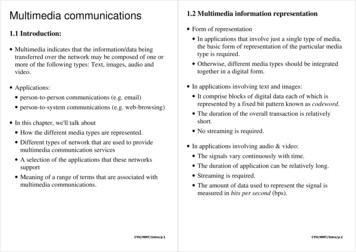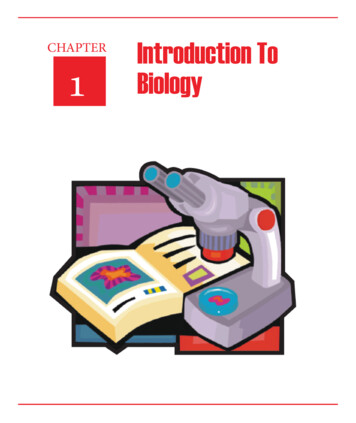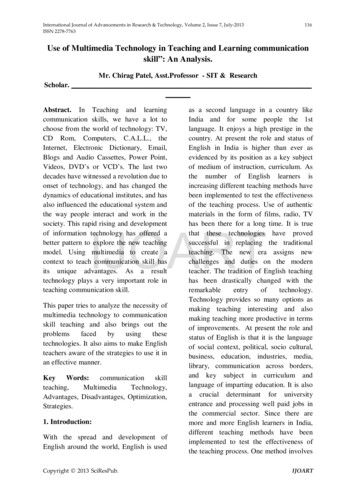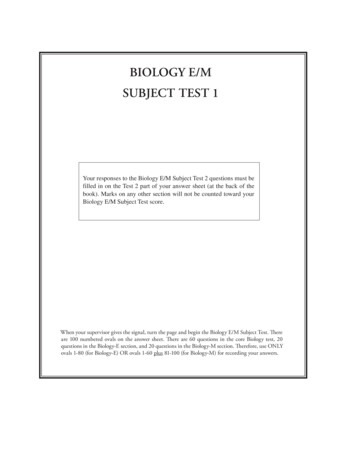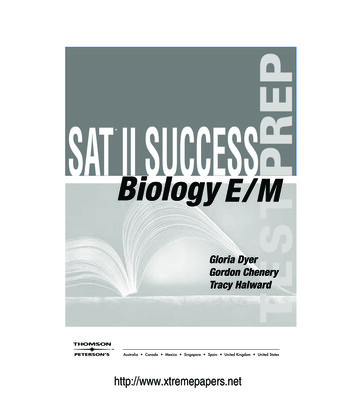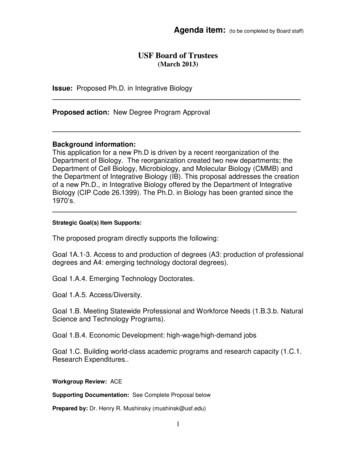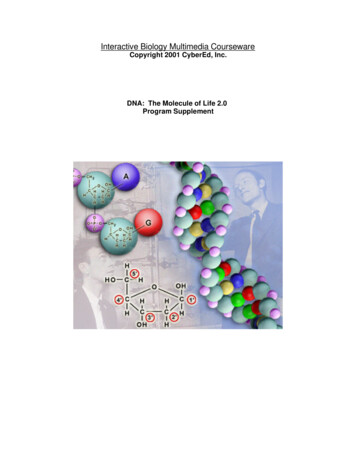
Transcription
Interactive Biology Multimedia CoursewareCopyright 2001 CyberEd, Inc.DNA: The Molecule of Life 2.0Program Supplement
Cyber Ed Multimedia Courseware – DNA: The Molecule of Life Program SupplementDNA: The Molecule of LifeTable of ContentsSubject:(Jump to page # )Page #Scenes 1-10Introduction and the Search for Heredity3Scenes 11-24Determining DNA Composition and Its Role in Heredity8Scenes 25-33DNA Structure14Scenes 34-43DNA Replication19Quizzes25Key to Quizzes33Multiple Choice Exam34Exam Key42Glossary43Page 2 of 48
Cyber Ed Multimedia Courseware – DNA: The Molecule of Life Program SupplementScenes 1-10Introduction and the Search for HeredityScene NumberI. IntroductionA. Introduction to Heredity, Genes, Traits and DNAB. DNA is Essential for Life(1)(2)II. The Search for HeredityA. Ancient BeliefsB. Gregor Mendel: The Father of Genetics(3)(4)III. Discovery of Nucleic AcidA. Fredrick Meischer and “Nuclein”B. Nuclei Acids: DNA and RNA(5)(6)IV. Discovery Of ChromosomesA. Chromosomes Appear Before Mitosis and MeiosisB. Walter Sutton, Theodore Boveri, And ChromosomalTheory of InheritanceC. Chromosomes Consist of Both DNA and Protein(7)(8, 9)(10)Page 3 of 48
Cyber Ed Multimedia Courseware – DNA: The Molecule of Life Program SupplementScene 1:This tiger cubresembles its parents andother tigers, yet it is verydifferent from this dolphin.Why? The answer lies in itsgenes. The cub inheritedgenes that make it closelyresemble its parents andgive it the characteristics, ortraits, that make it a tigerand not a dolphin. Today,we know that genes aremade of a substance calleddeoxyribonucleic acid, or DNA. However, it has only been since the middle ofthe 1900s that scientists have known the structure and function of DNA as theessential hereditary substance. This program will teach you about DNA, thesubstance that functions as genes and carries the information that made thisyoung cub a tiger, like its parents.Scene 2:DNA really is the molecule of life; it's life's information system. In additionto influencing how an organism looks and behaves, DNA tells cells how to grow,interact with other cells, and produce essential life -sustaining molecules. DNA isso important to life that nothing on Earth is considered alive unless it possessesDNA. In this program, you will examine historical experiments that providedclues to DNA's function as the carrier of hereditary information, and you will learnabout steps that led to the discovery of DNA's chemical structure. In addition,you will learn how DNA is duplicated and repaired before being transferred tonew living cells. The discovery of DNA is a history of scientific achievement anddemonstrates our capacity for deduction through the scientific process.Scene 3:Heredity, which is the transfer of characteristics, or traits, from parent tooffspring, is not a new concept. Stone tablets have been found that suggestancient Babylonians created pedigrees to document traits champion horsespassed to their offspring. However, nobody knew how or why such traits passedfrom generation to generation. People suspected something in blood carriedtraits; hence the term "pure bloodline" came to existence. Over two thousandyears ago, the Greek philosopher Aristotle suggested only males passedhereditary traits to their children; whereas others believed the female solelydetermined an offspring's traits. Eventually, the belief that a child inherited traitsrepresenting a blend of its parents' traits came to dominate thoughts on heredity.Page 4 of 48
Cyber Ed Multimedia Courseware – DNA: The Molecule of Life Program SupplementScene 4:Little occurred in thestudy of heredity until aperiod of rapid scientificadvances in the latter half ofthe 1800s. In the 1860s,Gregor Mendel (18221884), who eventually cameto be known as "the fatherof genetics," performed hisfamous experiments on peaplants. Mendel found thateach parent contributedsomething he called"factors" to the offspring. Individual "factors" influenced the form of a particulartrait. Traits were not simply a blend of the parents' characteristics. Sometimes atrait was dominant; that is, the trait was seen in the offspring even if just oneparent had the trait. He observed dominant traits in purple pea flowers.Sometimes a trait was recessive, as he observed with white pea flowers. Forrecessive traits to appear, the offspring must inherit a recessive factor from bothparents. These 'factors,' as Mendel described them, were divided up anddistributed to offspring independently, according to the laws of chance.Scene 5:The next step toward discovering the substance of heredity came in 1869,from a biochemistry student named Frederick Meischer. While studying whiteblood cells isolated from pus-filled bandages, he discovered that treating the cellswith acid would dissolve most of the cellular contents, leaving only the nucleus.If he treated the nucleus with alkali, and then acid, it yielded a grayish substancehe called nuclein. Later, others found that subjecting the nucleus to stains anddyes produced dark bands, which they called chromatin — a term derived fromLatin, meaning colored threads. Similar results were observed by treatingchromatin as Meischer had treated the nucleus, and the researchers concludedthat nuclein resided within bands of chromatin.Scene 6:Further research on chromatin found it contained large amounts of theelements Carbon, Hydrogen, Oxygen, Nitrogen, and Phosphorus; and it wasacidic. The term "nuclein" coined by Meischer was replaced by nucleic acid, andshortly thereafter, two types of nucleic acid were discovered: deoxyribonucleicacid, or DNA, found mainly in the nucleus, and ribonucleic acid, or RNA, foundmainly in the cytoplasm of the cell. At this point, scientists did not know the rolechromatin and the nucleic acids played in the cell.Page 5 of 48
Cyber Ed Multimedia Courseware – DNA: The Molecule of Life Program SupplementScene 7:In the 1880s, researchers observed that chromatin condenses into dense,darkly staining structures before cell division. These structures were given thename chromosomes, which literally means "colored bodies." Two differenttypes of cell division were observed, and in both, the chromosomes duplicatebefore being distributed to new cells. In one type of cell division, duplicatedchromosomes divide equally into two daughter cells. This was called mitosis.The other type form of cell division occurred in the production of gametes, or sexcells, such as the male's sperm or the female's eggs. In this type form , thechromosomes duplicate once, but two different cell divisions occur, yielding fournew cells with exactly half as many chromosomes as the original cell. This typeform , in which the chromosome number is reduced after division, was calledreduction division and later termed meiosis.Scene 8:In the early 1900s,Walter Sutton (18771916) and TheodoreBoveri (1862-1915)independently studiedgamete formation. Theyboth reali zed that anorganism's chromosomesexist in pairs, but thesperm and egg have onlyone set of chromosomes.When the sperm and eggjoin at conception, theyboth contribute chromosomes so that the new organism created has a paired setof chromosomes. This led to the "chromosomal theory of inheritance," whichsurmised that chromosomes carry hereditary units, and that the sperm and eggthat unite at conception each have half the number of chromosomes found in thetypical cells of the resulting offspring. Sutton and Boveri realized that thechromosomes inherited from the father's sperm and the mother' s egg could bethe independently assorting "factors" Mendel described. Since humans havethousands of different traits, but only 46 chromosomes in their cells, Suttonsurmised that each chromosome must contain many different hereditary factors,or genes.Scene 9:The famous geneticist, Thomas Hunt Morgan (1866-1945), supportedthe Chromosomal Theory of Inheritance with his pioneering work on fruit flies.Fruit flies have only four pairs of chromosomes and reproduce rapidly. Therefore,they make ideal subjects for the study of heredity, also known as genetics. Malefruit flies, like human males, have both an X and a Y chromosome whereasfemales have two X-chromosomes. He found that certain genes resulted in traitsPage 6 of 48
Cyber Ed Multimedia Courseware – DNA: The Molecule of Life Program Supplementin males that did not follow Mendel's dominant and recessive inheritancepatterns. Morgan realized that since males have only a single X-chromosome,they have just a single copy of the gene, and therefore, there could be nodominant or recessive pattern. This observation aided him in showing that aparticular gene could be traced to a specific chromosome. In further studies, hefound that genes for certain traits were arranged in a specific order alongchromosomes.Scene 10:To recap what you've learned — by this point in time, researchersdetermined that parents contribute hereditary information to their offspring. Thishereditary information was found in the chromosomes of the sperm and egg,which unite at fertilization to create a new organism. Chromosomes clearlycarried hereditary information in the form of genes, but researchers wereuncertain which component of chromosomes acted as genes. Chromosomeswere known to contain the nucleic acid, DNA, and further research showedchromosomes also contained protein. The next step in finding howchromosomes functioned as genes involved determining whether DNA or proteincarried the hereditary information. Many researchers suspected that proteinacted as genes because they thought DNA would be too simple of a molecule tocode for the diversity of traits found in living organisms. In the 1920s, a chemistnamed Phoebus Aaron Levene (1869-1940) performed experiments thatdescribed the chemical makeup of DNA. This furthered the belief that DNA wasa simple molecule.Page 7 of 48
Cyber Ed Multimedia Courseware – DNA: The Molecule of Life Program SupplementScenes 11-24Determining DNA Composition and Its Role in HeredityScene NumberV. DNA Chemical CompositionA. P.A. Levene Identifies DNA Components1. DNA is Composed of Sugars, Phosphate Groups(11)and Nitrogenous Bases2. Pyrimidines: Cytosine and Thymine, and Purimes:(12)Adenine and Guanine3. The Nucleotidea. Labeling Carbon Atoms Help Describe HowNucleotides Link Together(13,14)b. Is DNA or Protein the Hereditary Molecule?(15)VI. Experiments Leading to the Discovery of DNA as the Hereditary(Genetic) MoleculeA. Frederick Griffith’s Pneumococcus Experiment1. Unexpected Result(16,17)2. The Transfer of Genetic Material—Transformation(18)B. Avery, MacLeod, McCarty Cell Extract Experiment1. Identification of DNA as Hereditary Material(19)2. Science Remained Skeptical—Protein or DNA?(20)C. Chargaff Finds the Same Four Nucleotides in All Organisms1. Chargaff’s Rules(21)D. Hershey and Chase Bacteriophage Experiment(22)1. Experimental Design(23)2. DNA Shown to be Genetic Material(24)Page 8 of 48
Cyber Ed Multimedia Courseware – DNA: The Molecule of Life Program SupplementScene 11:Levene found that DNA consists of just three different units: sugarmolecules, phosphate groups, and nitrogen rich bases. These molecules arecomprised of the same chemical constituents researchers had earlier found inchromatin. The sugar molecules, called deoxyribose, are made of carbon,hydrogen, and oxygen arranged in a ring -like structure. The phosphate groupsconsist of a phosphorous atom surrounded by four oxygen atoms. The nitrogenrich, or nitrogenous, bases are the only molecules showing diversity in DNA;there are two types, purines and pyrimidines.Scene 12:The type ofnitrogenous bases calledpyrimidines, are sixmembered rings made ofcarbon, nitrogen, hydrogen,and oxygen. The other typeof nitrogenous bases, calledpurines, consists of fivemembered rings attached topyrimidine type of rings. Thetwo DNA pyrimidines arenamed cytosine andthymine, and the twopurines are adenine and guanine. These bases are commonly abbreviated asC, T, A, and G. Also, it helps to remember which nitrogenous bases arepyrimidines if you note that thymine and cytosine are spelled with a "Y," and so ispyrimidine.Scene 13:Levene also discovered one phosphate group and one deoxyribose sugarmolecule associate witheach nitrogenous base inDNA, creating a structureknown as a nucleotide.Since four nitrogenousbases exist in DNA, thereare four differentnucleotides. Later, Levenefound that the nucleotides inDNA link together at specificplaces by what is known asa phosphodiester bond.The nucleotides essentiallylink together like a chain.Page 9 of 48
Cyber Ed Multimedia Courseware – DNA: The Molecule of Life Program SupplementScene 14:You will notice thatmany atoms make up themolecules in DNA, and thestructures could quicklybecome confusing. Forthese reasons, chemistsnumber the carbons of thesugar molecules. This helpsto describe molecules anddiscuss where specificbonds form. For instancethe DNA sugar,deoxyribose, is easilydistinguished from the RNA sugar, ribose, because deoxyribose lacks an oxygenatom at the number two position in the ring. The phosphodiester bonds Levenedescribed occur when a phosphate group links sugar molecules togetherbetween the 5' (pronounced “5 prime”) carbon on one sugar, and the 3'(pronounced “3 prime”) carbon on the next deoxyribose sugar molecule.Because all of the nucleotides are linked together in this manner, molecularbiologists would refer to this DNA chain as being oriented in a 5' to 3' direction.Scene 15:Although Levene identified the individual components of DNA and themanner in which nucleotides link together, the larger structure these "chains ofmolecules" assembled into remained unknown. Since DNA consists of only fourdifferent nucleotides, researchers believed it to be a very simple molecule andfelt the nucleotides probably existed in equal amounts as a series of repeatingunits. Unfortunately, knowing the components of DNA did not solve the mysteryof whether the DNA or protein component of chromosomes functioned as genes.The next steps in identifying the hereditary molecule involved determining exactlywhich component carried genetic information.Scene 16:In 1928, a researcher named Frederick Griffith unexpectedly set thegroundwork for identifying the hereditary material during experiments he hopedwould lead to development of a vaccine against pneumococcus, a bacteriumthat causes pneumonia. Griffith worked with two types of pneumococci. Onetype caused a severe form of pneumonia and was named the smooth strainbecause it made large smooth colonies. The other type did not cause diseaseand made small rough colonies; therefore, it was called the rough strain. Quite byaccident, he discovered that some substance inside the cell could transform onestrain of bacterium into the other if the two strains were mixed together.Page 10 of 48
Cyber Ed Multimedia Courseware – DNA: The Molecule of Life Program SupplementScene 17:When Griffith injected mice with li ve, rough strain pneumococci, nodisease resulted, and the mice survived as suspected. When mice were injectedwith the smooth, disease-causing strain, they died of pneumonia. When Griffithkilled the smooth strain bacteria with heat, and then injected them into mice, nodisease resulted and the mice lived. The unexpected result occurred when hemixed heat-killed, smooth bacteria with live, rough bacteria and injected thismixture into mice. Instead of observing living mice as expected, the mice alldied. Griffith then examined the dead mice and found living, smooth strainbacteria.Scene 18:Griffith's unexpected result led him to suspect that genetic materialresponsible for giving the smooth strain bacteria its disease-causingcharacteristics had passed from the dead smooth strain bacteria to live roughstrain bacteria, transforming them into a smooth strain. The heat had killed theoriginal smooth bacteria, but obviously, the genetic material remained intactenough to transform the rough strain to smooth strain bacteria. Furthermore, thisgenetic change, which Griffith called transformation, was permanent. WhenGriffith isolated the transformed bacteria from dead mice and grew them in thelab, they continued to produce smooth colonies. Griffith discovered that geneticmaterial can be transferred, but he did not know which substance acted asgenetic material. A series of related experiments soon provided the answer.Scene 19:Griffith's transformation experiment excited a researcher named OswaldAvery, who set out to identify which cellular component could change the geneticmakeup of another organism. After about a decade of attempts, in 1944 Averyand his colleagues, Colin MacLeod and Maclyn McCarty published results ofan experiment tha t identified DNA as the hereditary material. The team ofscientists purified various substances from heat killed, smooth strainpneumococci and tested to see which substance could transform live, roughstrain bacteria to smooth strain. They tested proteins, fatty substances calledlipids, sugar based molecules called carbohydrates, and RNA — all withoutsuccess. When they finally tested the stringy substance called DNA, cells weretransformed, and they were sure DNA carried genetic information.Page 11 of 48
Cyber Ed Multimedia Courseware – DNA: The Molecule of Life Program SupplementScene 20:Although Avery and colleagues had demonstrated DNA was geneticmaterial, many scientists remained skeptical. Some researchers thought proteinhad contaminated the DNA, and was actually the genetic material. Othersdoubted that the genetic material of bacteria could be the same as that of morecomplex organisms such as plants and animals. DNA, containing its fourdifferent nucleotides of sugar, phosphate, and nitrogenous bases, was still widelyheld as being a simple molecule composed of repeating units. However, this didnot deter a young chemist named Erwin Chargaff from attempting to quantifythe DNA found in different organisms.Scene 21:Chargaff used newtechniques for separatingnitrogenous bases andfound that the same fourbases were present in theDNA of every organism hestudied. However, earlierbeliefs about DNAcomposition had beenwrong. DNA was not just arepeating series of the fourbases. Instead the quantityof bases differed in variousorganisms. There was, however, a definite pattern. The number of Adeninesalways equaled the number of Thymines and the number of Guanines equaledCytosines. Chargaff also noted that the quantity of the purines (adenine andguanine) equaled the quantity of pyrimidines (thymine and cytosine) in eachorganism. These two points were invariable, regardless of the organism studied,and eventually came to be known as Chargaff's rules.Scene 22:In the early 1950s, an experiment performed by Alfred Hershey andMartha Chase definitively showed that it was in fact DNA, and not protein, thatfunctioned as the hereditary molecule. The two researchers devised anexperiment using a virus called T2. T2 infects bacteria and is known as abacteriophage, or simply phage. Hershey and Chase knew that the T2 phageconsists only of DNA and protein, and they knew how it infects cells. T2 phageattaches to bacterial cells and injects its contents while the phage body remainsoutside the cell. The injected phage contents cause the cell to synthesize newphages until releasing them when the cell eventually bursts. Because thebacterial cell is literally re-programmed to produce phages, the researchers knewthat the substance phages inject into bacteria must be hereditary material.Page 12 of 48
Cyber Ed Multimedia Courseware – DNA: The Molecule of Life Program SupplementScene 23:Hershey a nd Chase created experimental conditions to test whetherphages inject protein or DNA into bacterial cells. The researchers knew thatprotein contains sulfur, whereas DNA does not. They also knew that DNAcontains nearly all the phosphorous in a phage. Therefore, the researchers wereable to use radioactive isotopes of both phosphorous and sulfur to label thesecomponents of the phages. Isotopes, as you may know, are often unstableforms of an element that emit radioactive particles of energy that can bedetected. By growing phage-infected bacteria in the presence of radioactivephosphorous, the phosphorous isotopes would incorporate into the DNA of anynew phage produced. Similarly, by growing phage-infected bacteria withradioactive sulfur present, the new phages would contain radioactive sulfurisotopes in their protein.Scene 24:In 1952, Hershey and Chase performed their famous experiment. Inseparate vessels, they placed phages with radioactive protein and phages withradioactive DNA to see which one would infect the non-radioactive bacteria.Afterward, the bacteria were placed in blenders to remove any phage parts thatremained attached to cells after injecting their contents. Next, each mixture wasrapidly spun in a centrifuge. Since bacteria are heavier than phages, theyformed a pellet at the bottom, while the phages remained suspended in solution.Finally, Hershey and Chase measured the radioactivity in the two separatevessels. In the sample containing phages with radioactive protein, most of theradioactivity remained in solution with the phages. In the sample with theradioactive DNA, the radioactivity was in the pellet of bacteria at the bottom,effectively showing that the phages had injected radioactive DNA into thebacteria. This proved to the world that DNA was the hereditary material.Page 13 of 48
Cyber Ed Multimedia Courseware – DNA: The Molecule of Life Program SupplementScenes 25-33DNA StructureVII.VIII.Scene NumberDetermination of DNA StructureA. X-ray Diffraction Shows Details of DNA Structure(25,26)B. Watson and Crick Correctly Identify DNA Structure(27)1. The Double Helix: Sugar-Phosphate Backbone and (28)Hydrogen Bonds Between Pairs2. Base Pairing Follows Chargaff’s Rules(29)3. DNA Strands are Antiparallel(30)a. DNA Structure Suggests How it Could(31)Replicate and Serve as GenesC. Watson, Crick and Wilkins Receive Nobel Prize(32)1. Further Studies Confirmed DNA StructureSequences of Nucleotides in DNA Function as Genes(33)Page 14 of 48
Cyber Ed Multimedia Courseware – DNA: The Molecule of Life Program SupplementScene 25:Once scientists identified DNA as the genetic, or hereditary molecule, thenext questions to answer were 1) how does DNA carry information and 2) howcan this information be copied every time a cell divides? Knowing the structureof DNA could answer the first question, and perhaps provide information for thesecond. Fortunately, many clues already existed. P.A. Levene had describedthe chemical nature of nucleotides, and the bonds that held them together.Chargaff had determined that there is the same amount of adenine as thymineand likewise for cytosine and guanine. The next major clues in determiningDNA's structure came from the work of researchers named Maurice Wilkins andRosalind Franklin who experimented with a technique called X-ray diffraction.Scene 26:In x-ray diffraction, researchers aim a beam of X-rays at a crystallizedform of the substance they wish to analyze. The X-rays interact with atoms in thecrystal and come out in a pattern captured on X-ray film. Although DNA does notactually form crystals, the DNA molecule is uniform enough that, when analyzed,the patterns it formed on film showed fine details about its structure. X-raydiffraction revealed DNA to be a large molecule made up of a number of spiraling—or helical— chain-like strands.Scene 27:A biologist namedJames Watson and aphysicist named FrancisCrick correctly identified thechemical structure of DNA in1953. After examiningprevious DNA research andstudying Rosalind Franklinand Maurice Wilkin's X-raydiffraction photos, Watsonand Crick came up with amodel for the structure thatpieced together all parts ofthe puzzle. The Watson and Crick DNA model had nucleotides arranged in theshape of a double helix – a structure resembling a long twisted ladder.Page 15 of 48
Cyber Ed Multimedia Courseware – DNA: The Molecule of Life Program SupplementScene 28:The two long, chain-like strands that make up the backbones of the doublehelix are alternating units of sugar and phosphate molecules that formphosphodiester bonds as Levene described in the 1920s. These long strandsare commonly referred to as the sugar-phosphate backbones of DNA. Thenitrogenous bases comprising each nucleotide exist in the center of the helix, likerungs of a ladder. This orientation protects the bases from water, which couldalter their structure, and allows weak bonds, called hydrogen bonds, to formbetween bases in a manner that holds the two chains of nucleotides together.Hydrogen bonds are quite weak by themselves, but when many hydrogen bondsoccur together, they can tightly zip-up a molecule. A similar principle applies toVelcro in which many tiny hooks and loops firmly fasten one object to another.Scene 29:Watson and Crickfound the double helix themost stable configuration forDNA. This structure fits theX-ray diffraction data andallowed for hydrogenbonding between bases. Intheir model, the two strandsof DNA run in oppositedirections and purines formbase pairs with pyrimidines.More specifically, theoptimal fit for base pairingoccurs when the purine, adenine, binds to the pyrimidine, thymine, and whenguanine and cytosine pair together. This orientation of DNA bases fits exactlywith Chargaff's rules. Since a purine always binds to a pyrimidine, it explainswhy there are always equal amounts of purines and pyrimidines in DNA.Additionally, the specific base pairs that form explain why adenine and thymineare equal in amount as well as guanine and cytosine.Scene 30:The alignment of the DNA strands in opposite directions is what peoplerefer to when they discuss the antiparallel nature of DNA. Earlier, you learnedthat the phosphodiester bonds holding the sugar phosphate backbone of DNAtogether occur between the 5' (five prime) end of one sugar molecule and the 3’end of the next. The antiparallel strands of DNA are positioned so that the 5' to3' orientation of molecules in one strand run in the same direction as the 3' to 5'molecule orientation in the opposite, or complementary strand. In other words,one strand of DNA is upside down in relation to the other strand.Page 16 of 48
Cyber Ed Multimedia Courseware – DNA: The Molecule of Life Program SupplementScene 31:Watson and Crick realized that their double helix model of DNA — with itsantiparallel strands and complementary base pairs -- could easily serve as atemplate for making new DNA strands. Remember adenine always pairs withthymine and guanine and cytosine always pair together. Simply separating thestrands and adding nucleotides to form the appropriate base pairs wouldgenerate the opposite or complementary strand of DNA. They also noticed howDNA could function as the genes we inherit from our parents. Since nucleotideswere limited only by the partner with which they could form base pairs across thestrands, they could exist in almost any ordered sequence along a strand of DNA.Watson and Crick noted that nucleotides arranged in different sequences alongeach strand of DNA could serve as genes and code for different traits.Scene 32:Subsequent studies of DNA structure confirmed the Watson and Crickmodel to be correct. For their work, they, along with Maurice Wilkins, receivedthe Nobel Prize in 1962. Unfortunately, Rosalind Franklin was not included.She had died previously, and the Nobel Prize is given only to living recipients.The structure of the DNA double helix was visually confirmed in 1969. As you willsee in the following scenes, the Watson and Crick DNA model provided thenecessary clues for answering how DNA acted as genes and how the geneticinformation could be copied before a cell divides.Page 17 of 48
Cyber Ed Multimedia Courseware – DNA: The Molecule of Life Program SupplementScene 33:Subsequent studiesconfirmed that sequences ofnucleotides in DNA are,indeed, genetic codes, orgenes. When DNAfunctions as genes, thenucleotides on a singlestrand of DNA are copied asa single strand of RNAnucleotides. RNA, as youlearned earlier, is the othertype of nucleic acid found inthe cell, and it is primarilyfound outside the nucleus. Once an RNA copy of DNA is made, it travels out ofthe nucleus where it interacts with structures responsible for protein synthesis.RNA therefore, acts as a messenger, which transfers DNA's genetic message toother molecules that perform work as coded for by the message. Specificmolecules bind to the RNA message, and a chain of amino acids is built inaccordance with the sequence of nucleotides. Different sequences of DNAproduce RNA coding for different chains of amino acids. The resulting chains ofamino acids are eventually folded into the various proteins and enzymesnecessary for the survival of the cell or the entire organism. The way in whichDNA nucleotides serve as genes that code for proteins, and how proteinsinflue nce an organism's traits is a fascinating, but complex topic that can bestudied in further detail in a text, or in other Cyber Ed programs.Page 18 of 48
Cyber Ed Multimedia Courseware – DNA: The Molecule of Life Program SupplementScene 34-43DNA ReplicationScene NumberIX. DNA Replication(34)A. Messelson and Stahl Semiconservative Replication(35)B. DNA Replication Process1. Origins of Replication and Replication Forks(36)2. Nucleotides are Attached to Elongating Strands(37)3. Synthesis Occurs in the 5’ to 3’ Direction(38)a. Leading Strand, Lagging Strand and OkazakiFragments4. Priming Begins Synthesis, and Ligase ConnectsFragments to Form Continuous Strands(39)C. DNA Replication is Rapid and Efficient(40)1. Errors in DNA Replication can be Repaired(41)D. DNA Interacts with Histones to Assemble into Chromatin(42)X. Conclusion(43)Page 19 of 48
Cyber Ed Multimedia Courseware – DNA: The Molecule of Life Program SupplementScene 34:The discovery of DNA structure helped explain not only how DNAfunct
Cyber Ed Multimedia Courseware - DNA: The Molecule of Life Program Suppl ement Page 7 of 48 in males that did not follow Mendel's dominant and recessive inheritance patterns. Morgan realized that since males have only a single X -chromosome,
